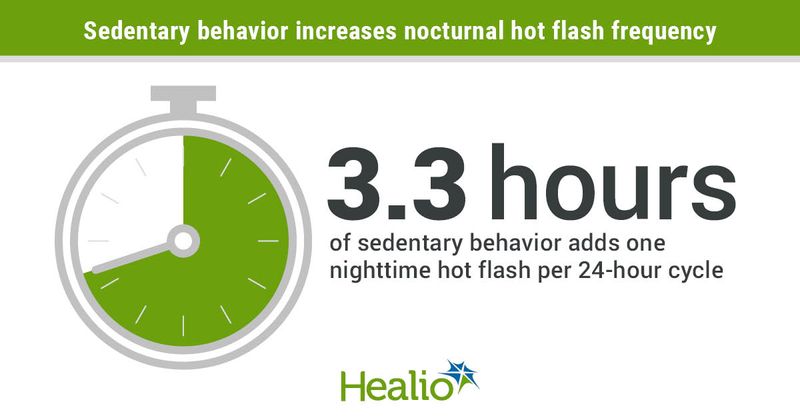Sedentary lifestyles may lead to more nocturnal hot flashes, greater CVD risk
Women with sedentary lifestyles face a greater risk for experiencing hot flashes at night, according to a study presented at the North American Menopause Society Annual Meeting.
Approximately 80% of women experience hot flashes, the researchers said, adding that a greater number and severity of hot flashes has been linked to an increased risk for CVD.

Sedentary behavior, which often is more prevalent as women age, also has been related to a greater risk for heart disease, the researchers continued.
“One of the interests in my lab is to better understand the relationship between physical activity, sedentary behavior and hot flashes. The reason we are interested is the relationship each of these has with CVD risk,” author Sarah Witkowski, MS, PhD, FACSM, an exercise physiologist at Smith College in Northampton, Massachusetts, told Healio.
Witkowski noted that increased frequency and severity of hot flashes also have been positively associated with subclinical CVD markers, clinical cardiovascular events and CVD mortality.

“Importantly, for perimenopausal women, there is a relationship between hot flash incidence and vascular dysfunction, which is an early risk indicator for CVD,” she said.
But few studies have evaluated the effect of sedentary behavior on the experience of hot flashes, the researchers said, and these studies largely were based on self-reports and did not consider objective measures of hot flashes or sedentary behavior.
“In addition, nighttime hot flashes are associated with sleep disruptions. Reduced sleep quality is related to increased risk for CVD. Therefore, while there is no current direct evidence for nighttime hot flashes and CVD risk, we are interested in evaluating this question,” Witkowski said.
The study included 13 premenopausal, 29 perimenopausal and 24 postmenopausal women aged 45 to 55 years to determine whether objectively measured sedentary behavior is a predictor of objective and subjective hot flashes.
The women were not taking hormone therapy or any other medication that would reduce hot flash frequency or severity. Also, they all had irregular menstrual periods or a last menstrual period within the previous 2 years.
The researchers simultaneously monitored the hot flash and sedentary behavior of the women for 24 hours. Objective hot flashes were measured via sternal skin conductance. Subjective hot flashes were measured when participants pushed a button on a monitor or recorded the incident in a diary whenever they felt one. Objective and subjective hot flashes occurring within 20 minutes of each other were deemed concordant.
The researchers measured sleep time through actigraphy taken via the wrist-worn accelerometer that the study’s participants wore for 24 hours, Witkowski said.
“Sleep time was used to evaluate hot flash experience during awake and nighttime periods,” she continued.
The participants experienced a mean (± SD) objective frequency of 0.254 ± 0.34 hot flashes an hour, a mean subjective frequency of 0.252 ± 0.62 hot flashes an hour and a mean concordant frequency of 0.09 ± 0.16 hot flashes an hour.
“Participants experienced an average of 4 ± 5 objectively measured hot flashes during the awake periods and 3 ± 2 objectively measured hot flashes during the nighttime period,” Witkowski said.
Bivariate analyses found a positive correlation between objective hot flash frequency and the duration of moderate physical activity (r = .285; P = .02) and moderate-to-vigorous physical activity (r = .303; P = .013). Also, the researchers found a positive correlation between concordant hot flash frequency with vigorous physical activity (r = .376; P = .002) and moderate-to-vigorous physical activity (r = .286; P = .02).
The researchers also found that the duration of sedentary behavior significantly predicted objective and concordant hot flashes, with objective hot flash frequency tincreasing by 0.28 per minute of moderate-to-vigorous physical activity (95% CI, 0-0.002; P = .032), which explained 6.8% of variation. Alone, moderate and vigorous physical activity did not have any significant associations with objective hot flash frequency.
Also, the researchers predicted an increase in concordant hot flash frequency of 0.283 per minute of vigorous physical activity (95% CI, 0-0.006; P = .035) and of 0.261 per minute of moderate-to-vigorous physical activity (95% CI, 0-0.001; P = .041). Vigorous physical activity explained 5.9% of the variation.
Finally, the researchers did not find an association between subjective hot flash frequency with any form of physical activity, nor did any physical activity explain more than 0.1% of variation.
Overall, the researchers said, their preliminary results indicate that sedentary behavior is predictive of nighttime objective hot flashes independently of time spent participating in moderate-to-vigorous activity, the researchers said.
“We found that time spent sedentary was a significant predictor of nighttime objective hot flashes. Approximately 200 additional minutes (3.3 hours) of sedentary behavior increased hot flash occurrence by one nighttime hot flash per 24-hour cycle,” Witkowski said.
“Importantly, when we controlled for physical activity, sedentary time was still a significant predictor of nighttime objective hot flashes,” she continued. “It is also worth noting that sedentary time was not related to awake objective hot flashes or subjective hot flashes.”
Women near the menopause transition spend a large portion of their daily activities in sedentary behaviors, the researchers said, making it important to understand how this behavior influences hot flashes. They also said that data about these issues can improve evidence-based lifestyle recommendations for women experiencing hot flashes.
“Our take-home message is that although these results are preliminary, reducing sedentary time may reduce bothersome nighttime hot flashes in midlife women,” Witkowski said.
The researchers plan to continue to collect data about the role of sedentary behaviors in hot flashes.
“We also have current work evaluating the relationships between physical activity, hot flashes and CVD risk,” Witkowski said. “We believe that the use of objective measurement of physical activity and hot flashes may improve our understanding of the relationships and help establish better evidence to support recommendations for midlife women.”
Reference:
Witkowski S, et al. Abstract P-23. Presented at: North American Menopause Society Annual Meeting; Sept. 22-25, 2021; Washington, D.C.

